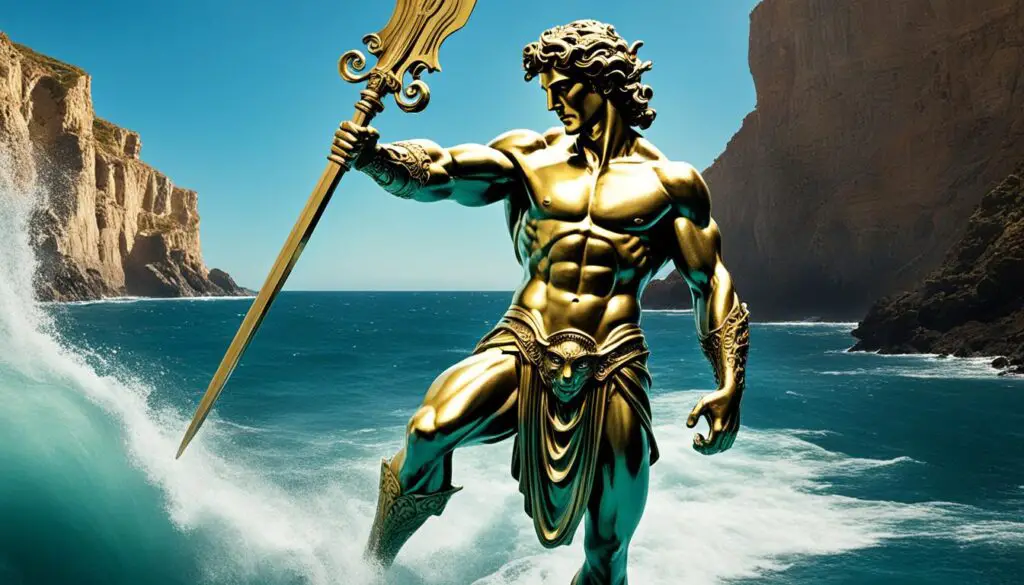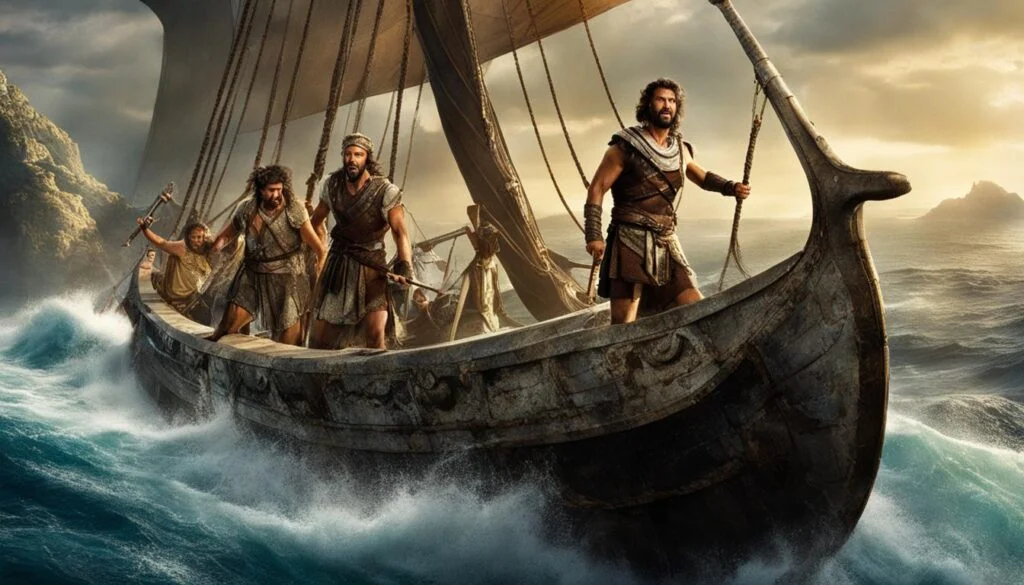Perseus is a well-known hero in Greek myths. He was born to the god Zeus and Danaë.
His story is famous for defeating Medusa and saving Andromeda from a sea monster.
These tales have been loved for centuries and have influenced art from ancient times.
His myth is also linked to the stars, with groups of stars named after characters from his story.
The story of Perseus showcases the power of heroes in Greek culture.
Key Takeaways
- Perseus is a celebrated figure in Greek mythology, known for slaying Medusa and rescuing Andromeda.
- The heroic deeds of Perseus, who was born to Zeus and Danaë, have inspired both ancient and Renaissance art.
- Figures from the Perseus legend, such as Cepheus and Cassiopeia, are represented as constellations in the night sky.
- Perseus’ myth is considered one of the greatest in Greek mythology, alongside heroes like Heracles and Odysseus.
- The story of Perseus combines themes of adventure, divine intervention, and heroic triumph.
The Birth and Early Life of Perseus
Perseus’ story starts in an amazing way. He was born from the love between the god Zeus and the human Danaë.
Acrisius, the Argos king, was afraid of a prophecy that said his grandson would end his life. To stop the prophecy, he locked Danaë away.
Parents of Perseus: Zeus and Danaë
Acrisius locked his daughter, Danaë, in a dark room. He hoped this would prevent her from having any children.
But Zeus, who couldn’t be stopped, turned into golden rain and entered her room. This is how Perseus was born, joining the world of gods with the world of humans.
Prophecy of King Acrisius
The prophecy warned that Acrisius would die by his grandson’s hand. Even though he tried hard to avoid this fate, Acrisius’ efforts were in vain.
Following the birth of Perseus, these events led to him sending Danaë and Perseus away in a chest on the sea.
A Life on the Island of Seriphus
They landed on Seriphus, where a fisherman named Dictys found them. He took them in and treated Perseus like his own son.
Here, Perseus grew up, showing amazing skills only a child of Zeus could have.
His time on Seriphus was crucial. Here, Perseus became a strong and skilled young man.
This prepared him for his future legendary adventures.
Who Was Perseus in Greek Mythology
In Greek mythology, the name Perseus shines with heroic tales. He is at the heart of the mythic hero legacy.
Known for his courage, wit, and fierce will, Perseus was the son of Zeus and Danaë, showing his godly roots.
Unlike some newer stories, the ancient myths rightly connect him with Zeus.
His adventures truly set him apart as a hero. For one, he defeated the Gorgon Medusa, showing intelligence and bravery.
He saved Andromeda from a sea monster, proving time and again his heroic mettle.
Interactions with mighty beings like the Titan Atlas and the Graiae sisters also revealed his strength and cleverness.
Perseus often interacted with gods, getting handy gifts from them. These included a special cap from Hades and magical sandals from Hermes and Athena.
Such aids helped him tackle very tough challenges.
One of his greatest heroic deeds was facing King Polydectes with Medusa’s head. By doing this, he showed all his true power and courage.
In the end, he always found a way to succeed against all odds. This makes Perseus a standout in Greek tales as a mythic hero.
Perseus’ story is more than just about himself; it shows how heroes are made. His success linked him with other greats such as Heracles.
Together, they form the backbone of legendary figures in Greek culture.
The Quest for Medusa’s Head
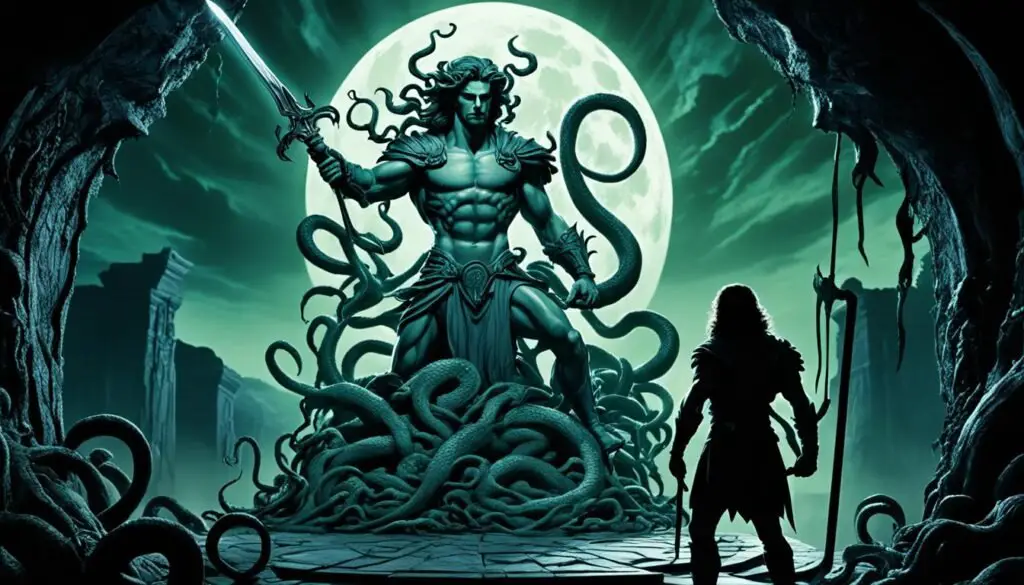
Perseus starts a heroic mission to get Medusa’s head. This venture is brought on by King Polydectes’ sly plans.
The journey shows how brave Perseus is and the roles of gods and foes.
The Devious Plan of King Polydectes
King Polydectes wants to marry Danaë and gets rid of Perseus. He tricks Perseus into a hard task: killing Medusa.
The king hopes this danger will end Perseus, making it easier for him to marry Danaë.
Divine Assistance from Hermes and Athena
Perseus succeeds thanks to the help of gods Hermes and Athena. Hermes’ gift of winged sandals makes travel quick.
Athena’s mirror shield helps Perseus face Medusa safely. These gifts are key in Perseus’s dangerous journey.
The Graiae Sisters’ Important Role
On his way to Medusa, Perseus tricks the Graiae sisters. They guard important secrets and only share one eye.
Perseus takes their eye to force them to tell him Medusa’s location. This information is crucial for Perseus to achieve his ultimate goal.
Perseus and Medusa
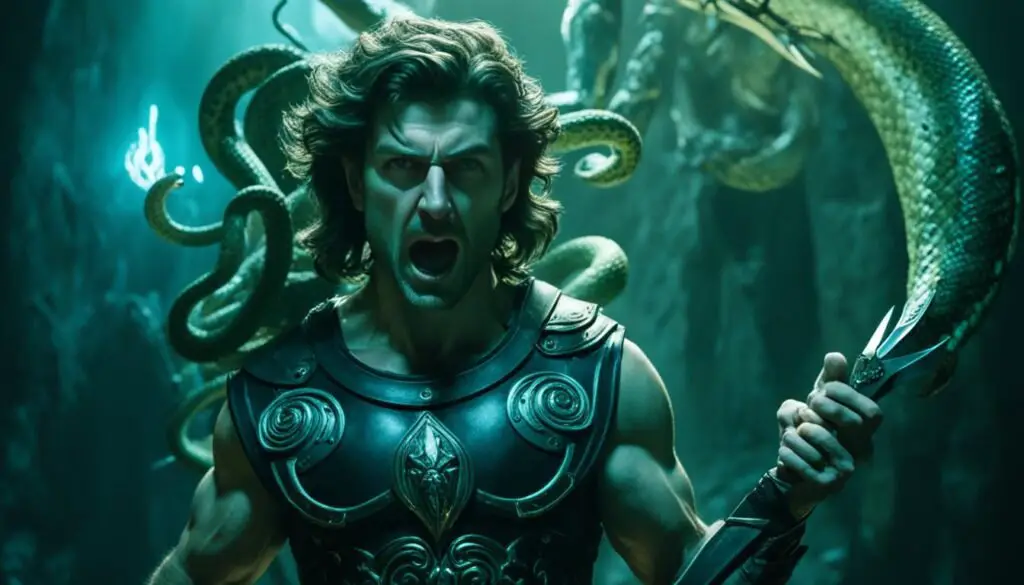
At the core of Greek mythology, you’ll find the famous story of Perseus and Medusa. This epic tale is full of danger, mystery, and the gods’ help.
It shows how Perseus became a hero and changed the world.
The Battle with Medusa
Perseus faced a very dangerous mission against Medusa. She was the only mortal among her gorgon sisters, making sure that whoever looked at her turned to stone.
Athena shared her wisdom with Perseus, while Hermes helped him fast. With a clever move, Perseus used a shiny shield to see Medusa through.
This way, he could cut off her head without danger.
The Birth of Pegasus and Chrysaor
When Perseus beheaded Medusa, something amazing happened. Out from her neck came the winged horse Pegasus and the warrior Chrysaor.
This unusual event made Perseus even more famous. It connected his story with these new mythological characters.
These happenings not just added to the beauty of Greek myths. They also showed something strange in their stories, the birth of Pegasus and Chrysaor from Medusa’s blood.
This shows the mysterious power of Greek creatures. The myth still inspires many artists, making Perseus and Medusa’s story a key part of classical myths and art.
Rescue of Andromeda
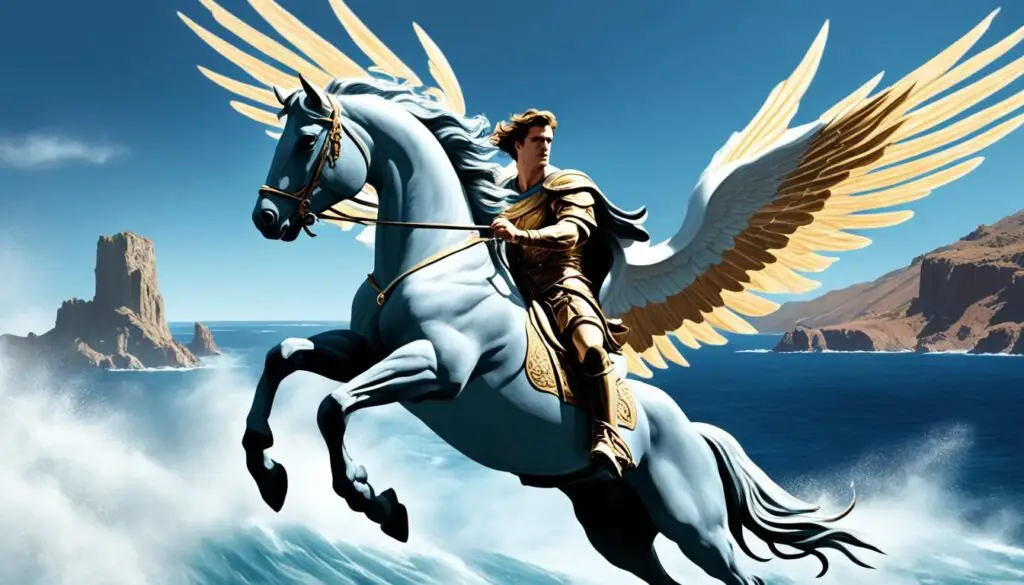
One of Greek mythology’s most thrilling tales is the rescue of Andromeda by Perseus. He found her chained, about to be fed to the sea monster Cetus, thanks to a foolish boast by her mother.
Cassiopeia wrongly thought Andromeda was more beautiful than the Nereids, and this angered Poseidon.
Perseus rescued Andromeda by killing Cetus. This act made their lives inseparable from legendary stories.
From ancient times until now, many artists and writers have told their story.
However, there is controversy about Andromeda’s portrayal. Modern discussions point out that she’s shown as white in art, even though historical texts suggest she may not have been.
This sparks a bigger debate about how different people and cultures are shown in art. Even with this debate, the story’s power endures through time and all around the world.
As a reward, Andromeda’s father allowed Perseus to marry her. The couple had nine children.
This event solidified their place in both earthly and heavenly myths, creating a lasting legacy.
The rescue of Andromeda is remembered in the stars. The constellation Andromeda, with its brightest star Alpheratz, honors her story.
Together with the Perseus and Cepheus constellations, it creates a skyward tribute to their epic adventure.
The Return to Seriphus
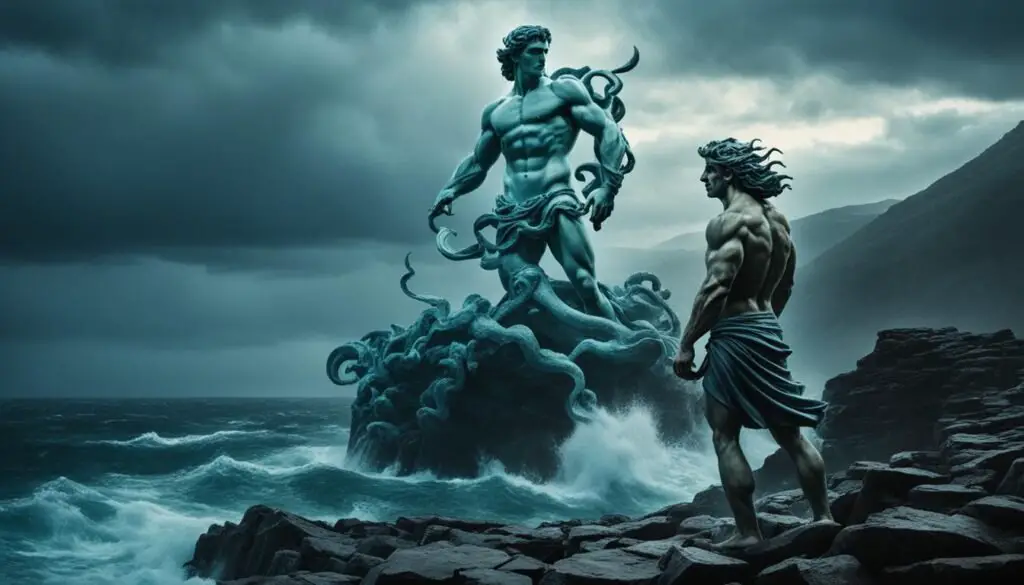
Perseus’s journey was full of mythical fights and help from the gods. But, his return home to Seriphus was a big victory.
After killing Medusa, he came back. This is when he found out his mom, Danaë, was in trouble with King Polydectes.
Perseus used Medusa’s head to deal with King Polydectes. He turned the king and his followers into stone.
This marked the end of his tough journey. Along the way, he got items like flying shoes and a magic wallet. The Graiae told him where to find these.
The trip back to Seriphus was more than just getting back at people. It was about saving his mother.
In doing this, Perseus showed he was a great problem solver. He became well-known, being a hero not just in Seriphus but in all of Greece.
Perseus’ Family Tree
Perseus was born to Danaë and Zeus, making him a key figure in Greek myths. His feats highlight his heroic nature and set the stage for the famous Perseid dynasty.
Marriage to Andromeda
Perseus’ marriage to Andromeda was a turning point in his story. He saved her from a terrible sea creature and won her heart.
This key event not only added to his hero status but also connected his family to Andromeda’s noble line.
Children of Perseus
Perseus and Andromeda welcomed seven kids into the world. They had Perses, Alcaeus, Sthenelus, Heleus, Mestor, Electryon, and Gorgophone.
Each child grew their family’s influence in Greek myths in significant ways.
Perseus’ Descendants
Perseus’ lineage continued to thrive after him. Perses is known for founding the Persian people. Heracles, another descendant, completed the famous twelve labors.
The Perseid dynasty’s impact is felt through many old Greek stories.
Founding of Mycenae
Perseus, after his quests, plays a key role in founding Mycenae. This city becomes one of ancient Greece’s most important places.
It is in the northeastern Peloponnese area, a cradle of Greek civilization mixing myth and history.
The area around Mycenae saw its first people in the Neolithic Age, about the 7th millennium B.C.
The city and the Perseid dynasty are closely tied, this dynasty is in Greek legends. The ruling class likely appeared roughly around 1700 B.C., starting Mycenae’s famous history.
Most famous Mycenaean landmarks, like the grand palace, were built in the late Bronze Age, around 1350 to 1200 B.C.
This time also saw the making of the sturdy city walls and the Lion Gate. The Lion Gate is a prime example of their building skill, using huge stone blocks.
Around 1200 B.C., Mycenae fell on hard times and started to decline. It was eventually left empty, 100 years later, after several fires.
Yet, its importance continued, with a temple either to Hera or Athena built in the 8th to 5th centuries B.C. on the old citadel.
In the Hellenistic period after Alexander the Great’s time, a village was built over Mycenae.
In 1874 and the 1950s, archaeologists like Heinrich Schliemann and George Mylonas found historic treasures there.
These artifacts are now seen in the National Archaeological Museum of Athens and the Mycenae Museum.
Mycenae became a UNESCO World Heritage Site in 1999. It symbolizes ancient Greek cities and keeps the stories of the Perseid dynasty and Greek legends alive.
Its high walls and the treasures in Grave Circle A share tales of ancient nobles, fascinating everyone interested in history.
Perseus in Art and Culture
Perseus’ impact on our culture dates way back, making its way into our art and stories.
He’s among the earliest heroes of Greek myths. His adventures, like defeating Medusa, have been part of art for a long time.
This ties into his family background, mixing gods and mortals.
When ancient Greek artists wanted to show Perseus, they gave him certain gear. He’d wear a special hat and have a pair of flying sandals.
And let’s not forget the bag he carried, called a kibisis, that held Medusa’s head. They used these items to show his story and importance.
The story of *Perseus and Andromeda* was a favorite for artists back then. They made it on things like vases and sculptures.
You’d see famous moments, like the sea monster fight. This made Perseus a big symbol of bravery and good in Greek tales.
Even in the Renaissance, artists were still inspired by Perseus and Medusa’s story. Writers like Sophocles and Euripides made plays about him, keeping his legend alive.
His action of defeating the Gorgon is celebrated for his courage and quick thinking.
But Perseus’ story isn’t just from the old days. It’s still loved today, shown in different kinds of art and even in movies.
His tale remains an important part of Western stories. He’s remembered as a key figure in early myths and as a brave hero in the stars.
Conclusion
Perseus is seen as a perfect example of the ideal hero in Greek myths. He highlights the fame and interest surrounding epic adventures and battles with monsters.
These stories show our love for struggles and victories of great figures.
Being from the Titan Oceanos’ line, Perseus is linked to the development of thought.
He teaches about freedom and how to win against life’s difficulties. His tales are full of symbolic wins, like defeating Medusa, which show conquering bad energies.
Perseus has a family line that includes Heracles, known for his freedom teachings. Others like Phoroneus and Niobe connect Perseus to the start of civilizations.
This makes him more than just a hero. He becomes a powerful symbol hero across history.
The saga of Perseus has greatly affected our culture. Places like Seriphus and Athens remember his bravery with joy and respect.
He mixes divine help with human courage, showing values like bravery, wisdom, and excellence. His genius and bravery have kept his myths beloved throughout time.
Frequently Asked Questions
What was Perseus the god of?
Is Perseus the son of Zeus or Poseidon?
Why is Perseus important?
What are three facts about Perseus?
1. He was born to Danaë while she was imprisoned in a bronze chamber by her father, King Acrisius of Argos.
2. He received divine assistance in his quest to slay Medusa, including winged sandals from Hermes and a reflective shield from Athena.
3. After defeating Medusa, he used her severed head to rescue Andromeda from a sea monster and later married her.


